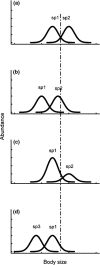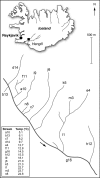Diatoms can be an important exception to temperature-size rules at species and community levels of organization
- PMID: 23749600
- PMCID: PMC4272575
- DOI: 10.1111/gcb.12285
Diatoms can be an important exception to temperature-size rules at species and community levels of organization
Abstract
Climate warming has been linked to an apparent general decrease in body sizes of ectotherms, both across and within taxa, especially in aquatic systems. Smaller body size in warmer geographical regions has also been widely observed. Since body size is a fundamental determinant of many biological attributes, climate-warming-related changes in size could ripple across multiple levels of ecological organization. Some recent studies have questioned the ubiquity of temperature-size rules, however, and certain widespread and abundant taxa, such as diatoms, may be important exceptions. We tested the hypothesis that diatoms are smaller at warmer temperatures using a system of geothermally heated streams. There was no consistent relationship between size and temperature at either the population or community level. These field data provide important counterexamples to both James' and Bergmann's temperature-size rules, respectively, undermining the widely held assumption that warming favours the small. This study provides compelling new evidence that diatoms are an important exception to temperature-size rules for three reasons: (i) we use many more species than prior work; (ii) we examine both community and species levels of organization simultaneously; (iii) we work in a natural system with a wide temperature gradient but minimal variation in other factors, to achieve robust tests of hypotheses without relying on laboratory setups, which have limited realism. In addition, we show that interspecific effects were a bigger contributor to whole-community size differences, and are probably more ecologically important than more commonly studied intraspecific effects. These findings highlight the need for multispecies approaches in future studies of climate warming and body size.
Keywords: Bergmann's rule; James’ rule; climate change; community size structure; diatoms; global warming; phytobenthos; phytoplankton; temperature-size relationships; temperature-size rule.
© 2013 John Wiley & Sons Ltd.
Figures




 vs.
vs.  for 91 pairwise comparisons. Recall that
for 91 pairwise comparisons. Recall that  . A 1:1 line divides the plot; points above the line represent pairwise comparisons where interspecific effects were the greater contributor to community size differences, and points below the line represent pairwise comparisons where intraspecific effects were the greater contributor. Triangles represent pairwise comparisons where intraspecific and interspecific effects were acting in opposite directions, and circles where they were acting in the same direction. Solid points represent pairwise comparisons where
. A 1:1 line divides the plot; points above the line represent pairwise comparisons where interspecific effects were the greater contributor to community size differences, and points below the line represent pairwise comparisons where intraspecific effects were the greater contributor. Triangles represent pairwise comparisons where intraspecific and interspecific effects were acting in opposite directions, and circles where they were acting in the same direction. Solid points represent pairwise comparisons where  was positive, so body size increased with temperature between the two streams, and open points where
was positive, so body size increased with temperature between the two streams, and open points where  was negative.
was negative.References
-
- Abramoff MD, Magalhaes PJ, Ram SJ. Image processing with Image J. Biophotonics International. 2004;11:36–42.
-
- Angilletta MJ, Niewiarowski PH, Dunham AE, Leache AD, Porter WP. Bergmann's clines in ectotherms: illustrating a life-history perspective with Sceloporine lizards. The American Naturalist. 2004;164:168–183. - PubMed
-
- Atkinson D. Temperature and organism size - a biological law for ectotherms? Advances in Ecological Research. 1994;25:1–58.
-
- Atkinson D. Effects of temperature on the size of aquatic ectotherms: exceptions to the general rule. Journal of Thermal Biology. 1995;20:61–74.
Publication types
MeSH terms
LinkOut - more resources
Full Text Sources
Other Literature Sources

